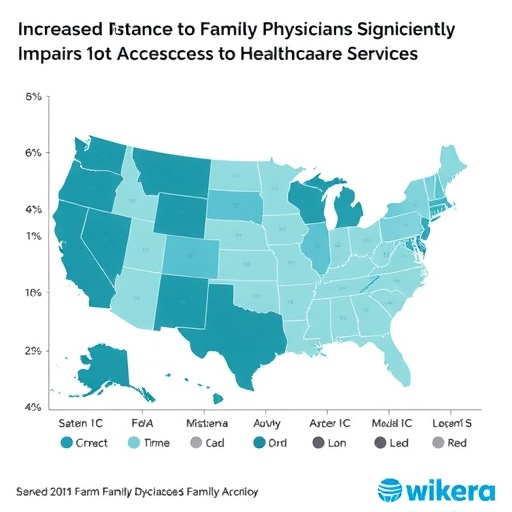Increased Distance to Family Physicians Significantly Impairs Access to Healthcare Services – Bioengineer.org

Report on Geographical Barriers to Primary Healthcare and Implications for Sustainable Development Goals
1.0 Introduction: Healthcare Access as a Cornerstone of Sustainable Development
An observational study conducted in Ontario, Canada, reveals that geographical distance is a significant impediment to accessing primary healthcare, directly challenging the achievement of key Sustainable Development Goals (SDGs). The research, analyzing data from nearly ten million patients, demonstrates that residing over 30 kilometers from a family physician adversely affects health service utilization and outcomes. These findings underscore that physical proximity to healthcare is not a matter of convenience but a fundamental determinant of health equity, impacting progress towards SDG 3 (Good Health and Well-being) and SDG 10 (Reduced Inequalities).
2.0 Key Findings: Quantifying the Impact on Health and Equity
The cross-sectional analysis identified critical disparities in healthcare engagement and outcomes, which directly contravene the principles of universal health coverage outlined in SDG 3.
2.1 Disparities in Healthcare Utilization
- Approximately 13% of Ontarians reside more than 30 kilometers from their primary care physician.
- This demographic exhibits a higher probability of utilizing emergency departments (ED) for nonurgent conditions, indicating a failure in accessible primary care which is essential for sustainable health systems (SDG 3).
- Affected individuals reported fewer appointments with their family physicians, undermining preventive care and the management of chronic conditions.
2.2 Vulnerable Populations and the Challenge to SDG 10
The study highlights that the burden of distance is not evenly distributed, exacerbating existing social and economic disparities and hindering progress on SDG 10 (Reduced Inequalities).
- Demographic Profile: Patients living farther from their physicians were more likely to be younger males, residents of low-income neighborhoods, and newcomers to the province.
- Intersectional Disadvantage: The geographical barrier compounds systemic challenges already faced by low-income and immigrant populations, creating a multi-layered impediment to equitable healthcare access.
- Gradient Effect: A direct correlation was found between increasing distance and adverse outcomes, with patients living over 150 kilometers away facing the highest odds of nonurgent ED visits.
2.3 Compromised Preventive Healthcare and Long-Term Health Outcomes
A significant finding was the negative impact on preventive medicine, a critical component for achieving long-term health and well-being as envisioned in SDG 3.
- Patients at greater distances had demonstrably lower participation rates in routine cancer screenings for colorectal, breast, and cervical cancers.
- This underutilization of preventive services directly translates to a higher risk of delayed diagnoses and poorer health prognoses, increasing morbidity and mortality rates that the SDGs aim to reduce.
3.0 Policy Implications for Advancing the Sustainable Development Agenda
The study’s conclusions present a clear mandate for policy reforms that integrate spatial equity into healthcare planning to build resilient and inclusive health systems in line with the 2030 Agenda for Sustainable Development.
3.1 Reforming Healthcare Delivery to Meet SDG Targets
- Strategic Physician Deployment: Policymakers are urged to implement reforms for the systematic deployment of family physicians in geographically isolated and underserved areas. This directly supports SDG 3.8 (Achieve universal health coverage) and SDG 10.2 (Promote universal social inclusion).
- Integrating Geographic Metrics: Health equity frameworks must incorporate geographical distance as a measurable determinant of access to ensure that infrastructure and services, as per SDG 11 (Sustainable Cities and Communities), are distributed equitably.
- Innovative Care Models: The findings support the adoption of telemedicine and decentralized healthcare hubs to bridge physical distances, leveraging technology to ensure continuity of care without compromising quality, a key strategy for resilient health infrastructure (SDG 9).
4.0 Conclusion: Spatial Equity as a Prerequisite for Global Health Goals
This research provides compelling evidence that geographical distance is a critical social determinant of health that materially impacts patient outcomes and exacerbates inequalities. Addressing these spatial barriers is not merely a logistical challenge but a fundamental requirement for making substantive progress on the Sustainable Development Goals. By prioritizing reforms grounded in geographical equity, governments can reduce pressure on acute care systems, improve population health, and build a truly accessible, patient-centered, and sustainable healthcare system for all.
Analysis of Sustainable Development Goals in the Article
1. Which SDGs are addressed or connected to the issues highlighted in the article?
- SDG 3: Good Health and Well-being
- SDG 10: Reduced Inequalities
2. What specific targets under those SDGs can be identified based on the article’s content?
-
SDG 3: Good Health and Well-being
- Target 3.4: By 2030, reduce by one third premature mortality from non-communicable diseases through prevention and treatment and promote mental health and well-being.
- The article directly connects to this target by highlighting how geographical distance from a primary care physician leads to “lower rates of participation in routine cancer screenings, including colorectal, breast, and cervical cancer checks.” Since preventive screening is crucial for reducing mortality from non-communicable diseases like cancer, the access barrier described impairs progress toward this target.
- Target 3.8: Achieve universal health coverage, including financial risk protection, access to quality essential health-care services and access to safe, effective, quality and affordable essential medicines and vaccines for all.
- The central theme of the article is the failure to provide equitable “access to quality essential health-care services” due to geographical barriers. The study shows that patients living far from their doctors had “fewer appointments with family physicians” and were more likely to use emergency departments for nonurgent needs, indicating a lack of access to routine primary care, which is a cornerstone of universal health coverage.
- Target 3.4: By 2030, reduce by one third premature mortality from non-communicable diseases through prevention and treatment and promote mental health and well-being.
-
SDG 10: Reduced Inequalities
- Target 10.2: By 2030, empower and promote the social, economic and political inclusion of all, irrespective of age, sex, disability, race, ethnicity, origin, religion or economic or other status.
- The article demonstrates how geographical barriers disproportionately affect specific vulnerable groups, leading to their exclusion from equitable healthcare. It states that patients living farther away “tended to be younger males under 65, dwellers in low-income neighborhoods, and newcomers to Ontario.” This shows an inequality in access based on economic status and origin, which this target aims to eliminate.
- Target 10.3: Ensure equal opportunity and reduce inequalities of outcome, including by eliminating discriminatory laws, policies and practices and promoting appropriate legislation, policies and action in this regard.
- The study reveals significant “inequalities of outcome” where distance correlates with “deteriorating access and increased reliance on acute care settings.” The article calls for policy reforms, such as the “systematic deployment of family physicians in underserved, geographically isolated areas,” to address the structural issues that create these unequal health outcomes, directly aligning with the goal of this target.
- Target 10.2: By 2030, empower and promote the social, economic and political inclusion of all, irrespective of age, sex, disability, race, ethnicity, origin, religion or economic or other status.
3. Are there any indicators mentioned or implied in the article that can be used to measure progress towards the identified targets?
-
Indicators for SDG 3 (Good Health and Well-being)
- Rate of non-urgent emergency department (ED) visits: The article uses this as a key indicator of poor primary care access, stating that patients living over 30km away had an “increased likelihood of visiting emergency departments (ED) for nonurgent needs.” Tracking this rate can measure access to routine care.
- Frequency of appointments with family physicians: The study found that the affected population “had fewer appointments with family physicians during the preceding two years.” This metric can be used to measure the utilization of primary healthcare services.
- Participation rates in preventive cancer screenings: The article explicitly mentions “lower rates of participation in routine cancer screenings, including colorectal, breast, and cervical cancer checks” as a negative outcome. These rates are direct indicators for measuring progress in preventive healthcare.
-
Indicators for SDG 10 (Reduced Inequalities)
- Percentage of the population living beyond a specific distance from their primary care provider: The study quantifies this, stating that “approximately 13% of Ontarians live more than 30 kilometers away from their family physician.” This geographic metric can be used to track the physical accessibility of healthcare services across a population.
- Healthcare utilization data disaggregated by demographic and socioeconomic factors: The article implies the use of this indicator by identifying that those living farther away were often “younger males under 65, dwellers in low-income neighborhoods, and newcomers to Ontario.” Analyzing healthcare access and outcomes for different demographic groups is essential to measure and reduce health inequities.
4. Summary Table of SDGs, Targets, and Indicators
| SDGs | Targets | Indicators |
|---|---|---|
| SDG 3: Good Health and Well-being |
3.4: Reduce premature mortality from non-communicable diseases through prevention.
3.8: Achieve universal health coverage and access to quality essential health-care services. |
– Rates of participation in routine cancer screenings (colorectal, breast, cervical). – Rate of non-urgent emergency department (ED) visits. – Frequency of appointments with family physicians. |
| SDG 10: Reduced Inequalities |
10.2: Promote the social inclusion of all, irrespective of economic or other status.
10.3: Ensure equal opportunity and reduce inequalities of outcome. |
– Percentage of the population living more than 30km from their family physician. – Healthcare access and outcome data disaggregated by income level, immigrant status, and location. |
Source: bioengineer.org
What is Your Reaction?
 Like
0
Like
0
 Dislike
0
Dislike
0
 Love
0
Love
0
 Funny
0
Funny
0
 Angry
0
Angry
0
 Sad
0
Sad
0
 Wow
0
Wow
0




















































.jpg.webp?itok=0ZsAnae9#)

















:focal(1500,1000)/https://media.globalcitizen.org/a6/9a/a69a4720-d8a1-4715-b596-18738d03c05c/rotary_polio_hero_image.jpg?#)








